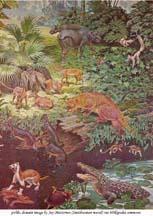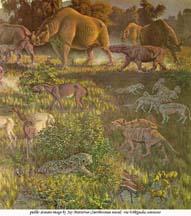What Is Chemical Makeup Of The Atmosphere During The Paleogene Period
The Paleogene Period* is the beginning of three periods comprising the Cenozoic Era. The Cenozoic, sometimes known as the "Age of Mammals", equally the Mesozoic was the "Age of Reptiles", is known by its Epochs. The Paleogene is composed of the get-go three of these Epochs, (Paleocene, Eocene, and Oligocene Epochs). Four boosted Epochs contain the Neogene and Fourth Periods that are to follow. The Paleogene sees the rapid filling of the environment following the K/T extinction, though it took more than two million years for the Earth's ecosystems to recover from this event. On country primitive mammals and birds began to spread rapidly. In the seas planktonic foraminifera and nanofossils begin new evolutionary paths. Most marine life resembles modern forms: the wonder of Cenozoic fossils is seeing recognizable organisms cast in rock, rather than the exotic, 'alien' life forms, such as sea lilies, ammonoids, and trilobites, of the Mesozoic and Paleozoic Eras. The three Epochs are discussed in more detail below. Additional information well-nigh the mammals of these epochs can exist found in our Prehistoric Mammals of the Cenozoic exhibits
Paleocene Epoch (65.5–55.eight Ma)
Small mammals and birds diversify in dense forests equally World recovers from the (Thousand-T) extinction. The loss of the giant reptiles that dominated the Mesozoic Era left the world open for evolutionary experiments by mammals and birds every bit they filled Globe's environments in turn.The diverse mammalian fauna remained pocket-sized, the largest only the size of a small pony. Ferns were initially arable following the K-T extinction, but flowering plants and conifers soon took over as they returned to abundance. Deciduous trees dominated swamp forests in Due north America from heart latitudes to the Arctic ocean. Grasses, an immensely important group in later epoch ecologies, originated early in the Paleogene. Insect herbivory finally recovered from the K-T extinction issue in the belatedly Paleogene, 9 million years after the event.
In the oceans, most reptiles vanished, turtles and crocodilians being exceptions. Sharks and teleost fish get more than common, and bony fishes dominate the seas as they will continue to do to the present day. Among invertebrates more modern forms of gastropods and bivalves, foraminiferans and echinoids announced. Every bit a result of diverse geological events like the island continent of India colliding with Asia, at that place was a rapid worldwide rise in temperature at the end of the epoch.
Eocene Epoch (55.8–33.9 Ma)
The Eocene begins with extreme Global warming, the warmest five 1000000 years of the Cenozoic. This warming was probably due to a big methane release from the ocean floor. Equally a upshot of global warming trees grew fifty-fifty in Polar Regions, while subtropical or tropical flowering plant forests cover most of what is now the United states of america. Palm trees grew in Alaska and Spitzbergen isle and crocodilians lived above the Arctic circle. Many new grasses evolve. Yet, grasslands had yet to develop and herbivorous mammals were browsers, feeding on leaves and herbs rather than grass. The outset odd-toed mammals (perissodactyls, such as rhinos and horses) and even-toed mammals (artiodactyls such every bit camels) were nowadays at the beginning of the epoch. The first marine mammals, including the first whales, announced in the seas, and the first primates appear on land. Large mammals make their start appearance on country, then die off by the end of the epoch. Carnivores include the first members of the domestic dog, weasel, bear and cat families. Most modern orders of bird had appeared by the Eocene. Africa is now an island continent. The climate began the long cooling trend that would proceed through the Cenozoic in the centre of the Eocene.

In the middle Eocene grasslands had not yet spread North America was dominated by forest and forest mammals every bit seen above. The odd-toed perrisodactyls, such as thePalaeosyopsin the rear eye had already appeared. In the copse next to them are the primitive rodentIschyrotomys and the primateSmilodectes. A group of primitive tapirs (Helatetes) are in the center of the frame. Just in front of them, looking at a group ofOrohippus (a perrisodactyl), is a predatoryPatreofelis. Only below a saber-toothedMachaeroides defends its kill (a lizard,Echmatemys) from the flim-flam-size carnivore,Sinopa. A couple of artiodactyls, the tinyHomacodon andHelohyus, are seen just above an edentateMetacheiromys leaving the frame above the saber-molar and its kill.**
Oligocene Epoch (33.9–23.0 Ma)
The global cooling that somewhen leads to later water ice ages begins during this epoch. Forests begin to shrink and grasslands expand at the expense of forests. Anthropoid apes make their outset advent. The newly opened landscapes favor the evolution of fast running prey and predators. Oreodonts were very mutual in North America along with three toed horses and a variety of rhino species. The giantIndricothere, a type of rhinoceros the size of a medium sauropod and the largest land mammal e'er, lived in central Asia. The anthropoid apes appeared during this epoch. Due south America, isolated for a few million years, evolves a distinct fauna including giant cannibal birds and predatory marsupials. Both cats and dogs were represented among carnivores, including saber tooth cats. In the body of water both seals and ocean lions announced late in this epoch. The two suborders of whales alive today, the toothed and baleen whales evolved. Invertebrates continued to look more than modern, while coral reefs spread in the southern hemisphere as far as New Zealand. South America breaks away from Antarctic, allowing an isolating circum-antarctic current and a permanent water ice cap to form, lowering world temperatures.

Dominating this scene in the altitude are giantBrontotherium, the largest land animals to ever alive in North America. Just in front of them is one the the first true rhinoceros,Subhyracodon, and in front of it is a group ofMerycoidodon herbivorous oreodonts. Next to them, in the middle of the frame, is aProtapirus, the commencement truthful tapir, that in plough is in a higher place a group ofPoëbrotherium, small ancestral camels. TwoHyaenodonfight over aGlyptosaurus lizard, while a saber-tooth true cat,Hoplophoneus lies in the bushes in the center foreground. Moving across the front from left to right a series of small-scale animals are seen: the primitive rabbitPaleolagus,the insectivoreIctops, 3 kinds of ruminants,Hypisodus, a couple ofLeptomeryx, and on the far correct lower corner, a group ofHypertragulus.**
*The term Paleogene is from Naumen'due south "Paleogen Stufe" (1866) in which he combined the Eocene and the Oligocene.
** The names and information apropos the animals in these murals are taken from the original legends in the 1964 Time-Life book, The State and Wildlife of North America, and may be outdated.
What Is Chemical Makeup Of The Atmosphere During The Paleogene Period,
Source: https://natmus.humboldt.edu/exhibits/life-through-time/visual-timeline/paleogene-period
Posted by: renfrofenly1968.blogspot.com


0 Response to "What Is Chemical Makeup Of The Atmosphere During The Paleogene Period"
Post a Comment